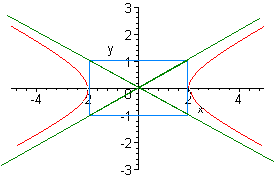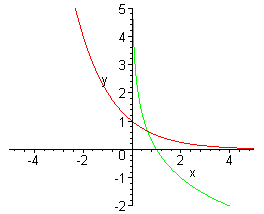Name
MATH 154 PRACTICE
MIDTERM II
Please work out each of the given problems. Credit will be based on the steps that you show towards the final answer. Do all your work and give all your answers on you own sheet of paper. Show your work.
Problem 1
Solve the following:
A. (10 Points) log6(x - 5) + log6(x) = 2
Use the sum to product rule of logarithms
log6[(x)(x - 5)] = 2
(x)(x - 5) = 62 Remember logs are exponents
x2 - 5x = 36 Multiplying out
x2 - 5x - 36 = 0 Subtracting 36 from both sides
(x - 9)(x + 4) = 0
x = 9 or x = 4
Notice that 4 is not a solution since it is not in the domain of log6(x - 5). 9 is a solution, as you can verify with your calculator.
B. (10 Points) 22x-1 = 53x-2
Take ln of both sides
ln 22x-1 = ln 53x-2
(2x + 1) ln 2 = (3x - 2) ln 5 Using the power to product rule of logs
2x ln 2 + ln2 = 3x ln 5 - 2 ln 5 Multiplying out
2x ln 2 - 3x ln 5 = -ln 2 - 2 ln 5 Separating x terms to the left and others to the right
x(2 ln 2 - 3 ln 5) = -ln 2 - 2 ln 5 Factoring out the x
-ln 2 - 2 ln 5
x =
= 1.1365 Dividing by 2 ln
2 - 3 ln 5
2 ln 2
- 3 ln 5
C. (10 Points) Use a calculator to evaluate log7 51
First use the change of base formula
log
51
log7
51 =
log 7
Now put this in your calculator to get
2.02055867514
Problem
2
The clarity C (in feet) of Lake Tahoe t years since 1990 can be modeled by the equation
C(t) = 45e-t/25
A. (9 Points) How clear was the lake in 1995.
The year 1995 corresponds to t = 5. Plug this in for t to get
C(5) = 45e-5/25 = 36.84
The clarity of the lake was 36.84 feet in 1995
B. (10 Points) When will the clarity of the lake only be 5 feet?
Now plug in 5 for C to get
5 = 45e-t/25
1/9 = e-t/25 Dividing both sides by 45
ln(1/9) = ln(e-t/25) Taking the ln of both sides
ln(1/9) = -t/25 Cancelling the ln and the e
-25 ln(1/9) = t Multiplying both sides by -25
t = 54.93
Now turn this back into a date by adding it to 1990
1990 + 54.93 = 2044.93
We can say that towards the end of the year 2044 the clarity of the lake will be only 5 feet.
Problem 3 Sketch the graphs of the given functions:
A.
(10 Points)
x2
+ 4y2 = 1
9
First notice that this is an ellipse since both coefficients are positive. Putting the 4 in the denominator gives
x2
y2
+
= 1
9
1/4
So that
a = 3 b = 1/4
The vertices of the ellipse are at
(3,0), (-3,0), (0,1/4) (0,-1/4)
Now plot the points and sketch the ellipse.

B.
(10 Points) x2 + y2 + 2x - 4y
- 4 = 0
First complete the two squares
x2 + 2x + (1 - 1) + y2 - 4y + (4 - 4) - 4 = 0 Reordering and adding and subtracting b/2 to both
(x + 1)2 + (y - 2)2 = 9 Factoring, adding -1 - 4 - 4 = -9, and adding 9 to both sides
We recognize this as a circle with center (-1,2) and radius 3. The graph is given below

C.
(10 Points)
![]()
Solution
This is a square root function, but instead of starting at (0,0), it starts at (4,-1) since plugging in 4 makes the inside of the square root negative and 0 - 1 = -1 gives the y value. We graph below.

Problem 4 (10 Points) Find the equation of conic with the graph shown below:

Since this is a hyperbola centered at the origin, we need to determine a, b, and the signs. Since the hyperbola has x intercepts, the coefficient in front of x is positive. We have
a = 2, b = 1
The equation is
x2
y2
-
= 1
4
1
or
x2 - 4y2 = 4
Problem 5 (20 Points) Determine whether the function is 1-1. If it is find the inverse and graph both functions on the same set of axes.
A. f(x) = (1/2)x
This function is 1-1 since exponentials are 1-1 (they pass the horizontal line test). The inverse of an exponential is a logarithm, that is
f -1(x) = ln1/2(x)
Below are the graphs. The red graph is f(x) and the green graph is f -1(x).

B. f(x) = |x - 4|
This is not 1-1 since it is a "V" shaped absolute value function. In particular
f(1) = f(5)
Problem 6 Expand each logarithm. Simplify where possible. Assume all variables are such that all expressions are defined.
A.
(10 Points)
x5y2
log3
81
Use the quotient to difference property of logarithms first:
log3(x5y2) - log3(81)
= log3(x5) + log3(y2) - log3(34) We used the product to sum property.
= 5 log3(x) + 2 log3(y) - 4 We used the product to sum property and cancelled the log3 and 3
B.
(10 Points)
![]()
Use the product to sum property of logarithms first and change the root into an exponent.
Warning: Do not cancel the root with the squares, since the "+" is in the way.
log5(x) + log5[(y2 + 25)1/2]
= log5(x) + 1/2 log5(y2 + 25)
Problem 7 Answer the following True or False. If True, explain your reasoning, if False, explain your reasoning or show a counter-example.
A.
(7 Points) The domain
of the function y = logb x
is (0, ![]() )
for all b > 0.
)
for all b > 0.
True, the domain of the log is the range of the exponential which takes on all positive numbers
B.
(7 Points) The
equation
![]() is undefined since you cannot take
the square root of a negative number.
is undefined since you cannot take
the square root of a negative number.
False, this equation is defined for all x less than or equal to zero.
C. (7 Points) If f(x) = x3 + x then f -1(3) = 1.
False, since
f(1) = 13 + 1 = 2 ![]() 3
3
Back to the Intermediate Algebra (Math 154) Home Page
Back to the Math Department Home Page
Questions, Comments and Suggestions: Email: greenl@ltcc.edu